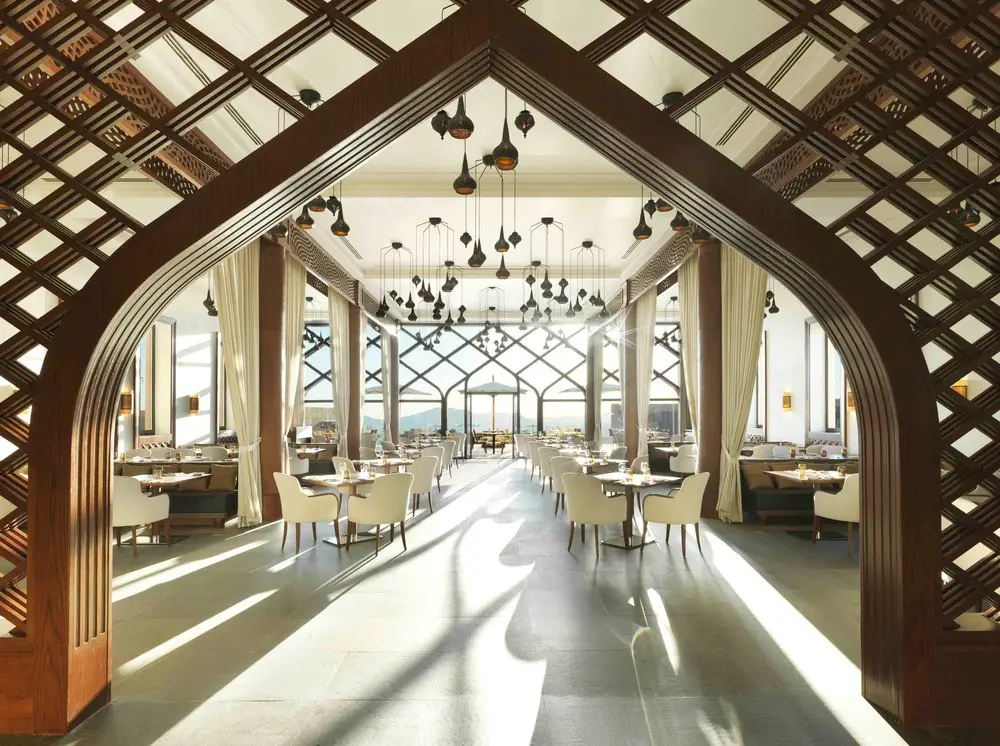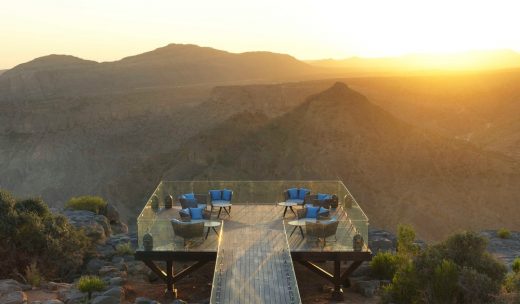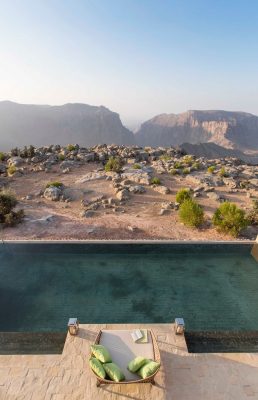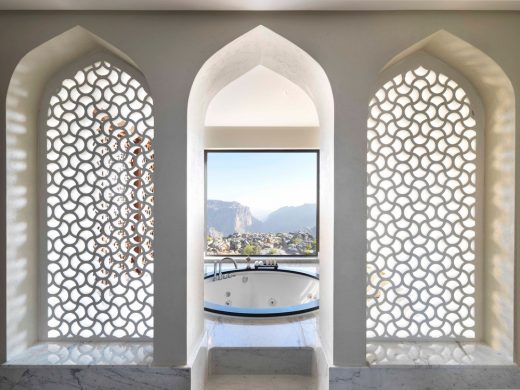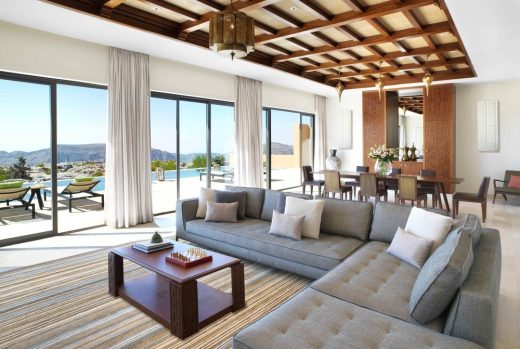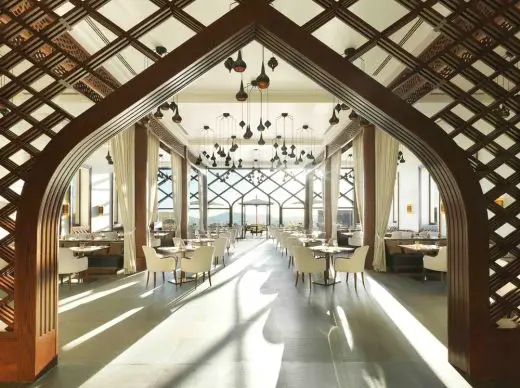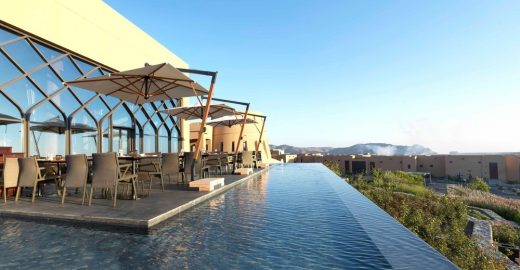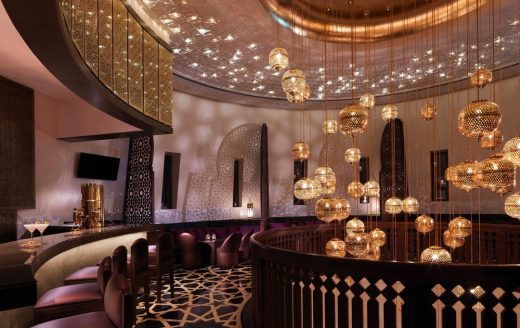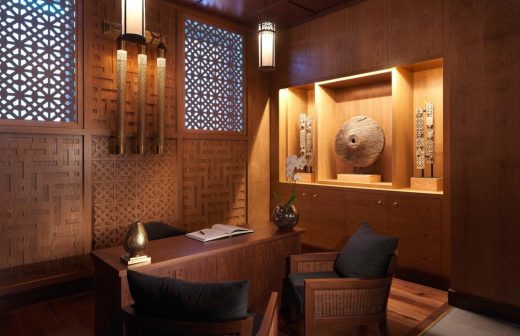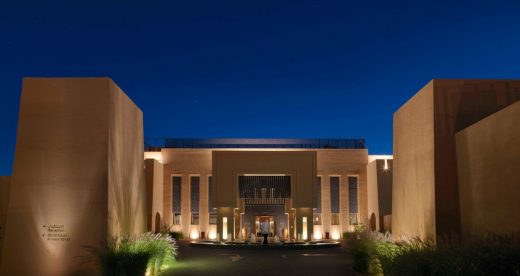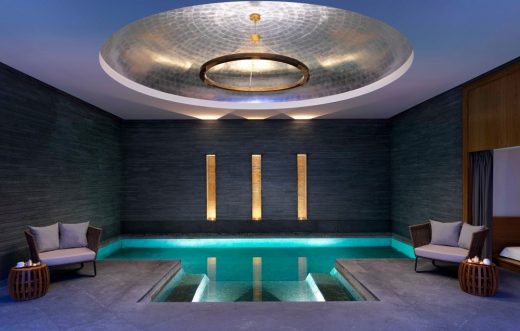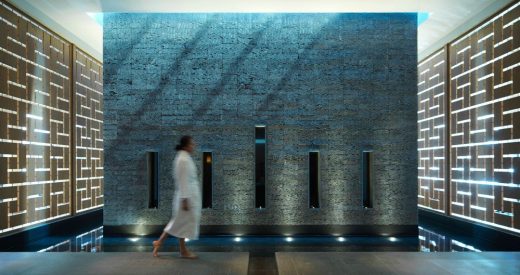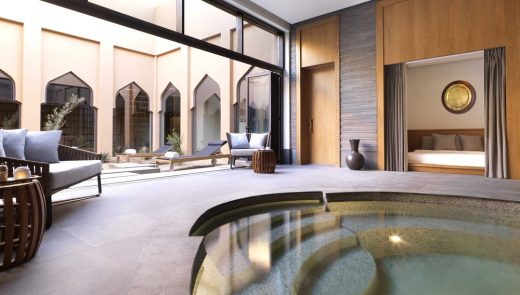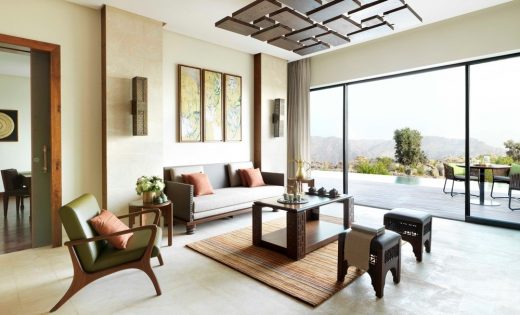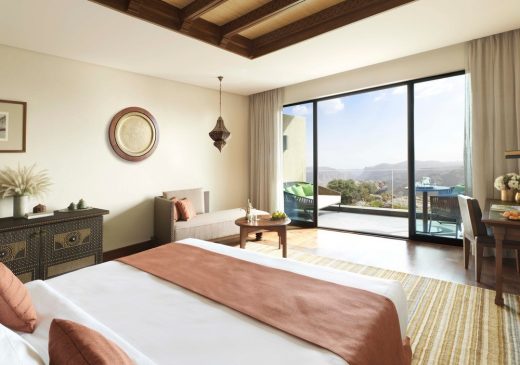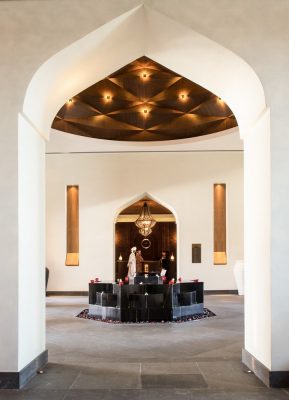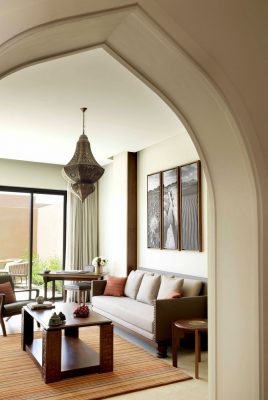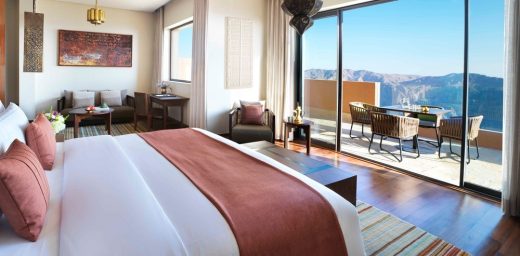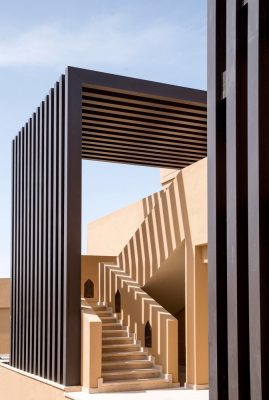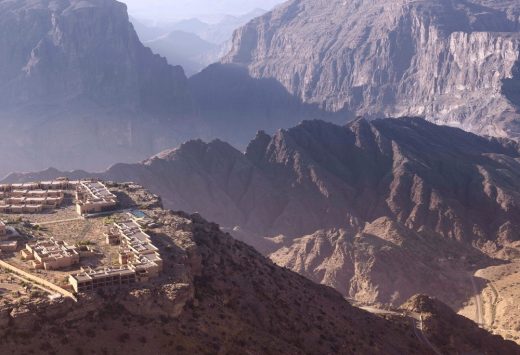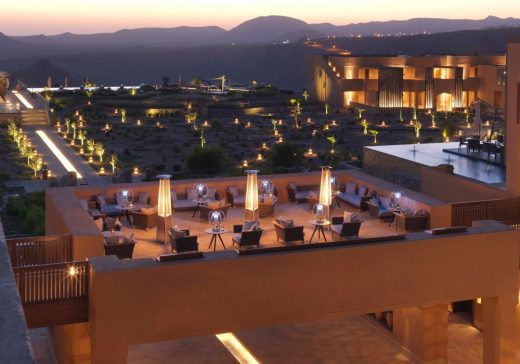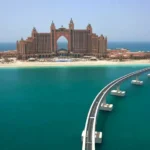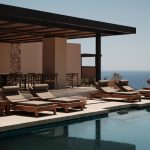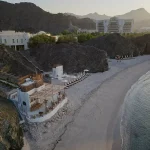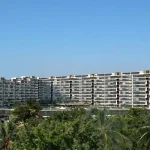Anantara Jabal Akhdar Resort Oman Building, Arabian Concept Project, Saiq Architecture Images
Anantara Jabal Akhdar Resort Oman
Arabian Hotel Accommodation in Nizwa, Saiq Plateau design by Atelier Pod Architects.
26 + 23 Mar 2017
Architects: Atelier Pod
Location: Nizwa, Saiq Plateau, Oman
Lotfi Sidirahal from Atelier Pod Designs the Highest Five Star Resort in the Middle East: Anantara Jabal Akhdar
Anantara Jabal Akhdar Resort
A design team immersed in Oman culture and legacy
Perched over 2,000 metres above sea level on the curving rim of a great canyon in Jabal Akhdar, Anantara Jabal Akhdar Resort was designed by Atelier Pod, the award-winning firm which specialises in creating strong identities, merging brand values and environment specificities. The studio was chosen to create the architecture and interior design of the resort, after being shortlisted amongst ten internationally recognised design companies.
The long inaccessible Jabal Akhdar, Arabic for “The Green Mountain”, is a towering massif on the Sultanate of Oman’s vast Saiq Plateau. The luxury resort is located on a 66,000 m² cliff edge plot, with a total built-up area of 24,000m² including 115 keys, six restaurants and lounges, a signature spa and recreation facilities.
Before embarking on the journey, Lotfi Sidirahal, Atelier Pod’s principle, spent several days with his team visiting the area in order to fully identify with the site’s locality on architectural, communal, and traditional scopes before initiating the resort’s design. The immersive excursion included meeting the mountains’ communities, re-drawing the architectural and landscape details of Birkat al Mawz and Jabreen fort, and of course exploring the primitive vernacular typologies that testify to the people’s historical lifestyle. This exploration phase preceding the design task was crucial for the team in order for them to create a unique and contemporarily rooted resort within the extraordinary heritage of the region.
The Atelier Pod team perceived how forms, volumes, play of light, use of materials, construction and decorative details of traditional Omani architecture and interiors, not only displayed harmony of form and function, but also how it responded to the local climate and culture. The studio contemplated long and hard on how to draw from these conventions in the project’s inception, ranging from the simple massing in the design of Bahla Fort to the delicate elegance of Jabrin Castle. The approach of Atelier Pod involved the innovative adaptation of vernacular elements to express the essence of local heritage.
A unique identity, new creative statements
Key elements in the character of Oman’s architecture are integrated into the resort’s concept without overshadowing its design. The resort reflects the fortification typology of the Nizwa region’s stronghold, ensconcing guests in modern ramparts inspired by the commanding mountain citadels and re-imagined with sophisticated modern interiors.
The sense of drama and beauty is heightened by the play of light and shade, the texture of the natural materials, rustling vegetation, and the sound of flowing water.
Stepping in an extraordinary setting
The designer configures visitors’ experience in sequences in order to arouse distinctive emotions inspired by the view, the architecture, and the landscape.
Sidirahal explains; “We designed the entrance with the idea of a fort in mind. The exterior, with its great wooden doors, impressively showcases commanding strength. There is a dramatic contrast upon entry as the interior gives a delicate and voluptuous impression with a majestic open courtyard featuring lush green terraces and a falaj.”
In the lobby, the guests are greeted by a wooden geodesic dome spanning over ten metres in diameter with a peaceful contemporary fountain centred beneath it. As they make their way through to the central courtyard decorated by revisited Omani arcades, they can catch a first glimpse of a striking rectilinear frame, increasing the perspectival depth of the mountain silhouettes, stretching over the garden terraces and beyond to the dramatic gorge.
With a large open fireplace serving as a central focal point, the courtyard is unmistakably the heart of the resort. An emanating protective warmth contrasts with the breathtaking cliff-side, injecting an invading vastness in the pool, rooms, and villas.
The patio brings together a souk, a coffee shop, a library, as well as pathways leading to the main restaurant and banquet facilities.
A freestanding tower on the western side of the courtyard is a testament to the ancient Omani Keep, or Burj, distinctive by its conical curvature and smooth encircling ramp, with an otherwise contemporary function. The tower houses a lounge and a specialty restaurant while also serving as an observation tower for a night under a blanket of stars. The rooftop was inspired by the high firing platforms of Nakhal Fort on one hand, and the rooftop courtyard of Jabreen Castle on the other.
Atelier Pod conceived every aspect of the resort to enrich the guest experience, designing not only architecture, interior design, and artworks but also the resort’s lighting design in collaboration with LDC Madrid, and landscape design with HED London. The meticulous attention brought to every nook and corner gave birth to an unprecedented resort in the region.
Interiors that convey local heritage
Designed to incorporate a reinvented sense of timelessness in the vein of rooted luxury, the elegant interiors reincarnate the surrounding culture, exuding a minimalist style infused with warm, rich colours alongside traditional features represented in local artwork, Arabesque lanterns, and handmade pottery. Indigenous iconic mountain roses, pomegranates and marine fossils permeate design choices, as reflected in the décor and artwork.
Describing the eighty pieces of custom designed furniture as “contemporary interpretations of traditional Omani design”, the studio used the patterns and architectural details found in doorframes, ancient ceilings, and traditional chests in order to generate a complete furniture line adapted to luxury resort standards. As Sidirahal puts it: “We tried to continue the Omani design DNA by inventing the missing genes”.
The ultimate aesthetic is never in contradiction with its environment and yet never the same.
A total of 115 luxury guest rooms and villas overlook either the dramatic canyon or tranquil gardens. The resort’s 82 Deluxe Rooms boast a spacious bedroom, amongst the largest in the country, and a spa-like bathroom complete with a rain shower and separate bath alongside a balcony. Meanwhile, the 33 One- or Two-Bedroom Villas grant guests an intimate escape, each with a private infinity pool overlooking the cliff or hiding in an exotic garden.
Other unique design elements include the spa, featuring the falaj-inspired canals, instilling the quiet sound of flowing water all throughout the resort. In the heart of the spa, a mysterious rough stone cube shields the sensual hammam, perpetuating the philosophy of contrast used by the designer.
The Omani tradition of integrating the ancient water channel system, called “falaj”, with cleansing spaces was adopted to offer intimacy to secluded areas around the spa. These areas harbour jacuzzis, daybeds, and hammocks.
This majestic resort is the fourth collaboration between Atelier Pod and Anantara Hotels, Resorts and Spa.
About Lotfi Sidirahal, Founder of Atelier Pod
Lotfi Sidirahal is a French Moroccan Architect, founder of Atelier Pod, an international architecture and interior design studio founded in Paris in 1999, with branches today in Dubai and Casablanca. An author of identities, he belongs to an exclusive elite of designers often called upon to design luxury branded hotels and resorts across the globe.
The designer recently completed the award-winning Radisson Blu Marrakech which launched in September 2016 as well as the comprehensive architectural and interior designs of the five-star Anantara Jabal Akhdar Resort, which opened in November 2016. Sidirahal’s ongoing projects include concept development for Paramount Hotels, a new international hospitality operator initiated by its Hollywood namesake studios, a luxury resort in the Maldives, a collaboration with Four Seasons Hotels & Resorts, and a fourth hotel with the Thai luxury hotel brand Anantara Hotels, Resorts & Spas, along with a number of prestigious private residences.
Sidirahal was interested in architecture from the word go, and after many successful exhibitions in the early days of his career, he founded an architectural experimentation laboratory in Paris. From there, Sidirahal’s interest grew and he turned to luxury brand design which led him to become the co-owner of Nebka, the Paris-based design firm that specialised in high-end luxury, frequently collaborating with Kenzo, Armani, Clarins, and Guerlain. His exposure to the world of luxury design compelled Sidirahal to delve deeper, only to find himself immersed in hospitality design to which he introduced his unique design vision, a culmination of his experience and exposure to the contemporary art industry and architectural avant-garde.
Lotfi Sidirahal’s early works, such as the “Nomambule”, stood as his refined discourse in architectural experimentation. An early exhibition in 2000 at Monaco’s Grimaldi Forum draws critic’s attention, most notably by the prestigious Vitra Design Museum, the historical first design museum in Europe, awarding Sidirahal an invitation to participate in the Berlin Blow Up Exhibition in 2001 and the Living in Motion exhibition in 2002. This further exposure urged a growing number of contemporary art and architecture museums to have Sidirahal’s works on display, most notably the Fundación Canal in Madrid, Graz Art Museum and the Institute of Contemporary Art in Boston, to name a few. The highlight however was in 2006 when the Seoul Hangaram Design Museum, one of the most influential design museums in Asia, commissioned Sidirahal to design a bespoke center-piece exclusively for their “Mobility” exhibition, which the architect named “Nolo”.
In 1999, Atelier Pod was formed using Lotfi’s innovative approach to challenge the field’s many limitations. To celebrate his hard work, in 2015 he was awarded two prizes in architecture and interior design at the Milan “A” Design Awards, the world’s largest annual juried design competition. Today, he is sought after by prestigious operators such as Accor Hotels, Hilton, Four Seasons Hotels & Resorts, Radisson Hotels, Anantara Hotels, Resorts & Spas and Fairmont Hotels & Resorts, where he ensures his signature work is in accordance with their brand image, surrounding culture, and an everlasting guest experience.
Born in Casablanca, Lotfi Sidirahal attended the higher education architecture programme at the Ecole Spéciale d’Architecture in Paris. Drawn to the city and its ubiquitous dynamics, Sidirahal earned his post-graduate degree in Urbanism at the Laboratoire de Géographie Urbaine, Paris.
List of main awards and exhibitions:
-First Exhibition at the Grimaldi Forum in Monaco in 2000.
-Creativity Prize at F.E.I.D.A.D in Taiwan « Far Eastern –International Digital Architecture Design Award ». in 2000.
-Nominated amongst the 40 Best young architects in the world at the Borromini Awards in Rome. 2001
-“Living in Motion exhibition” at the Vitra Design Museum in 2002
-Eiffel Tower Prize in Paris in 2002
-Exhibited at Fundacion Canal in Madrid in 2005.
-“Mobility” exhibition at the Hangaram Design Museum in Seoul in 2006.
-Exhibited at ICA, Institute of Contemporary Arts in Boston in 2006.
-Two prizes for Architecture and Interior Design at the “A” design Awards in Milan in 2015
Anantara Jabal Akhdar Resort in Oman images / information received 230317
Location: Nizwa, Oman, the Middle East
Oman Architecture
Oman Architectural Designs – chronological list
Al Madina Al Zarqa – The Blue City, Muscat
Architects: Foster + Partners
Blue City Oman
Yiti Resort & Spa Yiti
Design: RMJM Architects
Oman Resort Design
Cultural Centre in Muscat
Design: Architecture-Studio
Cultural Centre in Oman
Mutrah Fishmarket, Muscat
Architect: Snøhetta
Mutrah Fishmarket Muscat
Hotel Architecture Developments
Comments / photos for the Anantara Jabal Akhdar Resort, Oman Architecture design by Atelier Pod Architects page welcome

